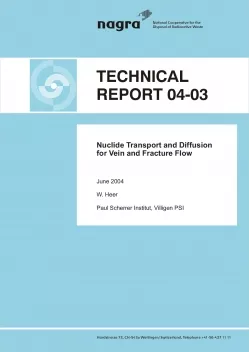
Technical Report NTB 04-03
Nuclide Transport and Diffusion for Vein and Fracture Flow
Modelling radionuclide transport through crystalline rock is usually based on a small water flow in a system of narrow fractures. This flow is denoted as fracture flow. In our model, it implies planar water-conducting channels and adjacent zones of dominant matrix diffusion. According to the constitution of the rock, it can be necessary to consider additionally a vein flow being characterized by cylindrical water-conducting channels and adjacent zones of dominant matrix diffusion. Transport calculations, based on a dual porosity concept, were performed for vein as well as for fracture flow. An extensive discussion of the results provides an overview on important parameter dependencies and on the major vein flow effects. Formulae for quick estimates are given to guide quantitative interpretation of break-through curves. The discussion of analytical results for nuclide diffusion from a planar and from a cylindrical boundary backs up the comments on matrix diffusion.
The following effects of vein flow onto the break-through curves are illustrative examples of useful findings:
- The peak height can be very strongly reduced compared to fracture flow. The peak arrival time, however, is only slightly changed.
- The asymptotic part of the tail is flatter than the well-known t -3/2 decrease for fracture flow.
- The bump at the end of the tail, generated by the limitation of the diffusion zones, is substantially larger than for fracture flow. A double-peak break-through curve, therefore, can emerge from many cases of nuclide transport.
- Sorption on the surfaces of diffusion-accessible pores can substantially change the break- through curves. The vein to fracture flow ratios of the break-through peak data, however, remain essentially equal. This holds for the whole range of investigated retardation factors from 7 to 27'000.
The investigations presented contribute to sophisticated interpretations of break-through curves and improve the physical understanding of nuclide transport in a dual porosity medium.
